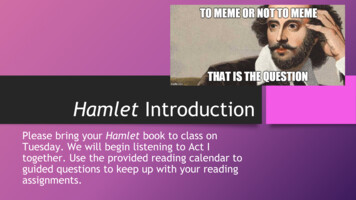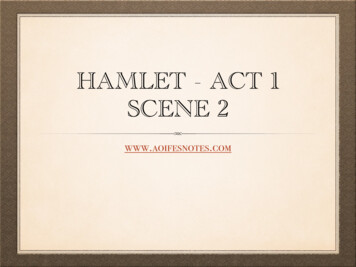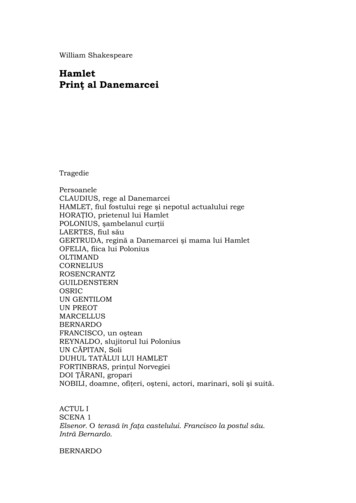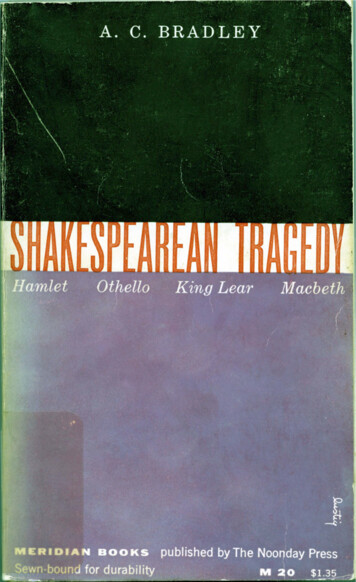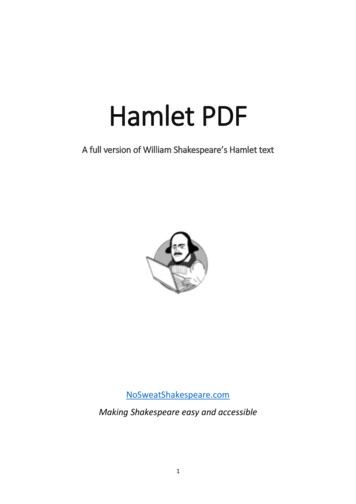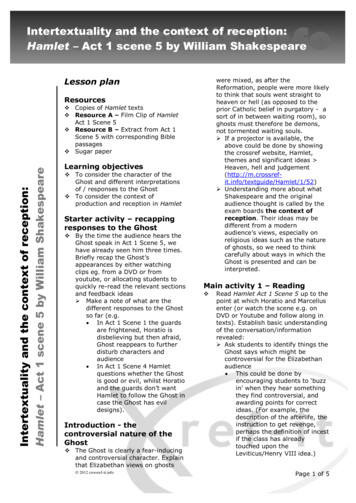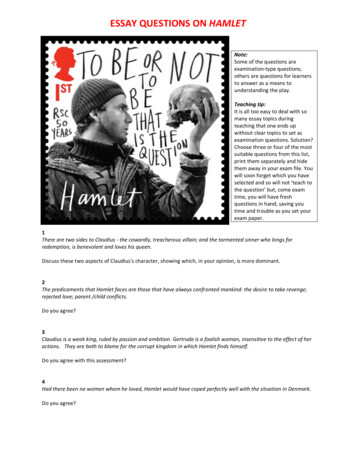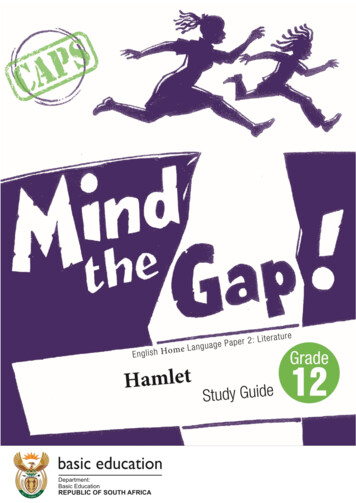
Transcription
Department of Basic Education 2020This content may not be sold or used for commercial purposes.Curriculum and Assessment Policy Statement (CAPS) Grade 12 English Home LanguageMind the Gap study guide for the play Hamlet by William Shakespeare ISBN 978-0-636-18000-0This publication has a Creative Commons Attribution Non-Commercial Sharealike license.You can use, modify, upload, download, and share content, but you must acknowledge the Department of BasicEducation, the authors and contributors. If you make any changes to the content and send the changes to theDepartment of Basic Education. This content may not be sold or used for commercial purposes. For moreinformation about the terms of the license please see: Copyright Department of Basic Education 2020 222Struben Street, Pretoria, South Africa. Contact person:Email:Tel: (012) 357 4502http://www.education.gov.za CallCentre: 0800202933The first edition of the series published in 2012 for the Revised National Curriculum Statement(RNCS) Grade 12 Mind the Gap study guides for Accounting, Economics, Geography andLife Sciences; the second edition of the series, published in 2014, aligned these titles to theCurriculum and Assessment Policy Statement (CAPS) and added more titles to the series, includingthe CAPS Grade 12 English Home Language Mind the Gap study guide for the play Hamlet byWilliam Shakespeare.Mind the Gap teamSeries managing editor:Production co-ordinators for CAPS edition:Authors: Colleen Joan Callahan, Selvie Chetty, Siphatisiwe Patricia Ndlovu Editor:Expert readers:Proof reader:Designer:Illustrators: Michele Dean, Ivan Keir, Vusi Malindi, Khosi Pholosa and Kenneth TekaneSeries cover illustration: Alastair Findlay Onsite writers’ workshop support:
Department of Basic Education 2020Ministerial forewordThe Department of Basic Education (DBE) has pleasure in releasing the third editionof the Mind the Gap study guides for Grade 12 learners. These study guides continuethe innovative and committed attempt by the DBE to improve the academicperformance of Grade 12 candidates in the National Senior Certificate (NSC)examination.The study guides have been written by teams of experts comprising of teachers,examiners, moderators, subject advisors and coordinators. Research, which began in2012, has shown that the Mind the Gap series has, without a doubt, had a positiveimpact on the improvement of results. It is my fervent wish that the Mind the Gapstudy guides will take us all closer to ensuring that no learner is left behind, especiallyas we celebrate 21 years of democracy.The second edition of Mind the Gap is aligned to the 2014 Curriculum andAssessment Policy Statement (CAPS). This means that the writers haveconsidered the National Policy pertaining to the programme, promotionrequirements and protocols for assessment of the National CurriculumStatement for Grade 12 in 2014.The Mind the Gap CAPS study guides take their brief in part from the2018/19 National Diagnostic reports on learner performance and draw onthe Grade 12 Examination Guidelines. Each of the Mind the Gap studyguides defines key terminology and offers simple explanations andexamples of the types of questions learners can expect to be asked in anexam. Marking memoranda are included to assist learners to build theirunderstanding. Learners are also referred to specific questions from pastnational exam papers and examination memos that are available on theDepartment’s website – www.education.gov.za.The CAPS editions include Accounting, Economics, Geography, LifeSciences, Mathematics, Mathematical Literacy and Physical Sciences. Theseries is produced in both English and Afrikaans. There are also English FirstAdditional Language (EFAL) study guides. These include EFAL Paper 1(Language in Context); EFAL Paper 3 (Writing) and a guide for each of theGrade 12 prescribed literature set works included in Paper 2 for both EFALand EHL.Please remember when preparing for Paper 2 that you need only study the setworks you did in your EHL class at school.The study guides have been designed to assist those learners who havebeen underperforming due to a lack of exposure to the contentrequirements of the curriculum and aim to 'mind-the-gap' between failing
Department of Basic Education 2020and passing, by bridging the gap in learners’ understanding of commonlytested concepts, thus helping candidates to pass.All that is now required is for our Grade 12 learners to put in the hoursrequired to prepare for the examinations. Learners, make us proud ANDstudy hard. We wish each and every one of you good luck for your Grade 12examinations.Matsie Angelina Motshekga, MPMinister of Basic Education2020Matsie Angelina Motshekga, MPMinister of Basic Education
Department of Basic Education 2020Table of contentsDear Grade 12 learnerHow to use is study guideTop 7 study tipsOn the exam dayOverview of Paper 2What is a contextual questionWhat is a literary essayWhat are the examiners looking forQuestion wordsBack to the 0000000IntroductionSettingFacts about the playBackground: antecedent actionThe great chain of beingPoints to remember when reading HamletChronological timeline of Hamlet2 Structure, plot and sub-plot2.1 The plot summary2.2 CharactersClasses of charactersCharacters in HamletDiagram of relationships2.3 Themes2.4 Act-by-act summary, analysis and activitiesAct 1Act 2Act 3Act 4Act 5000000000000000000000000003Stage-directions in Hamlet and activity004The soliloquies of Hamlet005 Contextual questionsActivity 1Activity 2Activity 3000000006 Literature essaysActivity 1Activity 2Activity 3000000007 Suggested answersThemesAct-by-act activitiesAct 1Act 2Act 3Act 400000000000000Mind the Gap English Home Language: Paper 2 Hamlet INTRODUCTION ix
Department of Basic Education 2020Act 5Stage-directionsContextual questionsActivity 1Activity 2Activity 3Literature essaysActivity 1Activity 2Activity 300000000000000000000Rubric for Literature essays00References00Mind the Gap English Home Language: Paper 2 Hamlet INTRODUCTION ix
Department of Basic Education 2020Dear Grade 12 learnerThis Mind the Gap study guide helps you to prepare for the end-ofyear Grade 12 English Home Language (EHL) Literature exam.There are three exams for EHL: Paper 1: Language in Context; Paper 2:Literature; and Paper 3: Writing.Paper 2: Literature involves the study of novels, drama, seen andunseen poetry. A Mind the Gap study guide is available for each ofthe prescribed literature titles.This study guide focuses on William Shakespeare’s play, Hamlet, oneof the set works in Paper 2: Literature.How to use this study guideIn the introduction to the guide (pages 00), you will find informationabout the author and the events that influenced his writing. There isalso an overview of how the story is told.From page 00 to 00 you will get the Act-by-act notes to help you understand: The characters; What happens and who is involved; The themes; The symbols, diction and figurative languageLook out forthese icons inthe study guideActivities withPay special attentionquestions for youto answerHints to help you remembera concept or guide you insolving problems.Mind the Gap English Home Language: Paper 2 Hamlet INTRODUCTION ix
Department of Basic Education 2020Try thesestudy tips tomake learningeasier.Top 7 study tips1.Divide your workload into manageable sections. This will helpyou to focus. Take short breaks between studying one sectionand going onto the next.2.Have all your materials ready before studying a particularsection of your work – pencils, pens, highlighters, paper,glass of water, etc.3.Be positive. It helps you to retain information.4.You learn better when using colours and pictures. Try to usethem whenever you can.5.Repetition is the key to remembering information you havelearnt. Constantly go over your work, until you can recall itwith ease.6.Work with a partner. Teach each other what you have learnt.It is definitely worth reading your revision notes aloud.7.Sleep for at least eight hours every night. Eat healthy foodand drink plenty of water to stay refreshed. Studying forexams is like exercise, so you must be prepared bothphysically and mentally.Mind the Gap English Home Language: Paper 2 Hamlet INTRODUCTION ix
Department of Basic Education 2020Use thisstudy guide as a workbook.Make notes, draw picturesand highlight importantideas.On the exam day1.Make sure you have pens that work, sharp pencils, an eraserand a sharpener. Make sure you have your ID document andexamination admission letter. Arrive at the exam venue at leastan hour before the start of the exam.2.Go to the toilet before entering the exam room. You don’t wantto waste valuable time going to the toilet during the exam.3.It is a must to know how many questions from each of the threesections of the paper, you will be answering. Use the 10minutes’ reading time to read the instructions carefully, as areminder of what is expected of you.4.Break each question down to make sure you understand whatis required of you. Misunderstanding any part of the questionwill lead to loss of marks. Focus on the key words for a betterunderstanding of the question. You will find a list of somequestion words on page ix of this study guide.Mind the Gap English Home Language: Paper 2 Hamlet INTRODUCTION ix
Department of Basic Education 20205.Manage your time carefully. Start with the question you think isthe easiest. For the contextual questions, check the markallocation for each question so you give the correct number ofpoints in your answer.6.Do not panic during the exam. All questions are linked to whatyou learnt in the course of the year. Don’t get stuck onquestions you are finding difficult to understand; move on andcome back to those if time allows. Try to answer as manyquestions as possible, though.7.Write neatly so the markers can read your answers easily.Mind the Gap English Home Language: Paper 2 Hamlet INTRODUCTION ix
Department of Basic Education 2020Overview of paper 2Here is a summary of the Literature exam (paper 2):Question numberQuestionType ofquestionNumber ofmarksSection A: POETRY Answer questions on TWO prescribed poems AND the questions onthe unseen poem (compulsory).1Prescribed poemPoetry Essay 102Prescribed poemContextual103Prescribed poemContextual104Prescribed poemContextual105Compulsory:Unseen poemContextual106The Picture ofDorianGrayEssay257The Picture ofDorianGrayContextual258Life of PiEssay259Life of PiContextual25Total25Section B: NOVEL Answer ONE question.*
Department of Basic Education 2020Section C: DRAMA Answer ONE elloEssay2513OthelloContextual2514The CrucibleEssay2515The CrucibleContextual25Total25In Sections B and C, answer ONE ESSAY and ONE CONTEXTUAL question. Youmay NOT answer TWO essay questions or TWO contextual questions. If you answer the ESSAY in Section B, then you must answer the CONTEXTUALquestion in Section C. If you answer the CONTEXTUAL question in Section B, thenyou must answer the ESSAY in Section C. You may NOT answer TWO contextual questions or TWO essay questions. During the reading time at the beginning of the exam, find the questions on the setworks you have studied for Sections B and C and read through the questions. Choose the essay question you will answer from Section B/C and the contextualquestion you will answer from Section B/C. Number your answers correctly – according to the numbering system used in the exampaper – for the two sections you have chosen.
Department of Basic Education 2020What is a contextual question?In a contextual question, you are given an extract (about 25–30 lines) from thedrama. You will then have to answer questions based on the extract. Someanswers can be found in the extract. Other questions will test yourunderstanding of other parts of the drama: plot, characters, symbols andthemes. Some questions will require that you express your opinion about thedrama.What is a Literary Essay?Writing literary essays is a skill requiring preparation, planning and practice.When answering literary essays, you do not re-tell the story. Instead , youneed to focus on specific requirements of the set essay question. The numberof paragraphs in your literary essay will depend on what the question requires.The following table guides you through the preparation and planning processesof literary essays. It may be used to practise your writing as you work throughthe activities given later in this guide.[Source: https://www.clipart.email]Mind the Gap English Home Language: Paper HamletINTRODUCTION xii
Department of Basic Education 2020PREPARATIONTHE QUESTIONRewrite the question given.QUESTION FOCUSWhat aspect (e.g.theme/character/plot/style)does the question need you towrite about.QUESTION REQUIREMENTWrite down the key instructionwords (e.g. discuss, analyse,explain) in the questionPLANNINGINTRODUCTIONWrite your topicstatement for theessay.BODYFor each paragraph write a topic sentence and fill in key-words accordingto the PEEL method of ceLinkCONCLUSIONWrite yourconcluding sentence,and make sure itlinks with the topicstatement in yourintroduction.PRACTICEUse the information you have written in the table above to assist you in answering your literaryessay.Mind the Gap English Home Language: Paper HamletINTRODUCTION xiii
Department of Basic Education 2020What are the examiners looking for?Examiners will assess your answers based on: Your understanding of the plot (story line). Your ability to reorganise information. For example, you may be asked tosummarise key points or to compare and contrast character traits.Your ability to provide information that may not be clearly stated in the extract using what you already know about the text. This process is called inference.This may include explaining how a figure of speech affects yourcomprehension of the drama.Your ability to make judgements about certain aspects of the text andpresenting your opinions based on information given in the play.This process is called evaluation. For example, you may be asked if youagree with a statement or to discuss a character’s motive. Your ability to respond to the characters in the text and how this appeals toyour emotions. This is called appreciation. For example, you may be askedhow you think a certain characters feel, or what you would have done if youwere in their situation. You may also be asked to discuss how the writer’sstyle clarifies your understanding of the drama.[Source: https://www.beeswaxrubberstamps.com]Mind the Gap English Home Language: Paper 2 HamletINTRODUCTION xiv
Department of Basic Education 2020Question wordsHere are examples of types of questions you will meet in your English HL examination.Question typeWhat you need to doLiteral: Questions about information that is clearly given in the text or extract from the text.Name characters/places/things . Write the specific names of characters, places, etc.State the facts/reasons/ideas Write down the information without any discussion orcomments.Give two reasons for/why Write two reasons (this means the same as ‘state’).Identify thecharacter/reasons/theme Write down the character’s name, state the reasons,write down the themeDescribe theplace/character/what happenswhen Write down the main characteristics of something, forexample: What does a place look/feel/smell like? Is aparticular character kind/rude/aggressive? Write downthe sequence of events What does character x do when ?Write what happened – what the character did.Why does character x do ?Given reasons for the character’s action according toyour knowledge of the plot.Who is/does ?Write the name of the character.To whom does xx refer ?Write the name of the relevant character/person.Reorganisation: Questions that need you to bring together different pieces of informationin an organised way.Summarise the main points/ideas Present the main points, keeping mark allocation in mind. Group the common elements Combine the things which share the same features.Give an outline of.Present the main points, keeping mark allocation in mind.Place the extract in context Explain how the events of the extract fit intothe sequence of the story.Inference: Questions that need you to interpret (make meaning of) the text usinginformation that may not be clearly stated. This process involves thinking about whathappened in different parts of the text; looking for clues that tell you more about acharacter, theme or symbol; and using your knowledge to help you understand thetext.Explain how this idea links withthe theme x Identify the links to the theme.Mind the Gap English Home Language: Paper HamletINTRODUCTION xv
Department of Basic Education 2020Compare theattitudes/actions ofcharacter x with character y Point out the similarities and differences.Do you agree thatthe represents the contrastbetween Point out the differences and come to a conclusionwhich shows your agreement or not. Whatever yourchoice, you need to support your answer withevidence from the text(substantiate your answer).What do the words suggest/reveal about ?State what you think the meaning is, based on yourunderstanding of the text.How does character x reactwhen ?Write down the character’s reaction/what the characterdid/felt.Describe how something affectedcharacter x State how you know thatcharacter x is What did character x mean bythe expression ?Explain why the character used those particular words.Make sure that you refer to specific words.Explain the cause/effect of Write the reason(s) for /Give the repercussions of How does iterary deviceaffect your understanding ?How does the rary device contributes to yourunderstanding of the text.What, do you think, wouldbe the outcome/effect/etc. ofan action/situation ?Explain what the consequences of the action/situationwould be.Account for Give the reasons for.What does the word/linesuggest / imply ?Explain what the word/line suggests.For similes and metaphors, discuss the comparison andhow it adds meaning to the text.Evaluation: Questions that require you to make a judgement based on your knowledgeand understanding of the text and your own experience. There is no ‘right’ or ‘wrong’answer to these questions, but you must give a valid reason for your opinion based onevidence from the text.Discuss your view/a character’s Write down what you think about the given the givenaspect of the text.feelings/a theme .Do you think that What are your views/opinion on the given topic.Do you agree with/that.?You need to state whether you are of the same opinionor not.Mind the Gap English Home Language: Paper HamletINTRODUCTION xvi
Department of Basic Education 2020In your opinion, what State your viewpoint and support it with evidence fromthe text.Give your views on What do you think of.? Use evidence from the text.In light of the drama as a whole, Present a detailed answer focusing on the main pointsof the argument.critically discuss In your view, is justified?Give reasons, based on the text, why you/a character/thewriter adopt(s) a particular standpoint.Comment on What do you think of.? Provide evidence from the textto support your opinion.Critically comment Give a detailed responce on the required information,with evidence from the text to support your line ofthought.Appreciation: Questions that involve your emotional response to plot, characters and/or style. There is no ‘right’ or ‘wrong’ answer to these questions. You need to give avalid reason for your opinion, based on specific information from the text.How would you feel if you werecharacter x when ?Imagine that you are character x, and describe youremotions.What is your response to ?What effect does.have on you?Do you feel sorry for ? / Do you State YES or NO and say why you feel that way.identify with ?Discuss the writer’s use ofstyle, diction and figurativelanguage, dialogue State how the given aspects of the drama are used togive the text a specific effect.Comment on theWhat is the writer's purpose in using. ( impact)appropriateness/effectiveness ofa figure of speech/literarydevice Mind the Gap English Home Language: Paper HamletINTRODUCTION xvii
Department of Basic Education 2020Katlego took herScience Expoexperiment a bittoo far and beforeshe could figureout what washappening, shewas standing ina street in London,in the year 1600.She approacheda boy of her ownage.Hey, dude! I don’t havethe faintest idea where I am.Must be in a city somewhere inSouth Africa, because I think Irecognise the soccerstadium.Soccer? What is soccer?That building is the Globe Theatre.It can seat 3 000 people. Our mainplaywright is William Shakespeare. Hehas staged so many plays there, hepractically owns the place.Wow! That’s awesome! Is this guystill alive? I read that he was born inApril 1564 and died in 1616. He wrote38 plays and over 150 poems.Ben Jonson was rightto call Shakespeare awriter for all times.Who are you? Andwhy are you wearing thatsurgical instrument over yourears? And yes, Shakespeare isvery much alive. This is Londonin the year 1600. I’m Edward,welcome to my world!Mind the Gap English Home Language: Paper HamletINTRODUCTION xviii
Department of Basic Education 2020Incredible! I am Katlego andI am from the 21st century. Ilive on the tip of Africa.You won’t believe this, but westill study the plays of Shakespeare for ourfinal matric exams. After all these years!These are headphones. I use them to listento music on my MP3 player.Headphones? That's fascinating.I hope you enjoyyour studies. Shakespeare alwayswanted his audiences to have FUN!Yes, it is a tragedy and thedeaths are necessary for therestoration of order.We are studying Hamlet. Itis a tragedy and a sadstory, involving severaldeaths.Basically, good triumphs overevil.That’s great! Is it truethat only male actors areallowed to performin plays?Yes, acting is no jobfor a woman! Young boysplay the parts writtenfor ladies.People from all levelsof society attend plays. It canget chaotic because the audienceopenly show their enjoyment ordislike of what they see on stage.Even Queen Elizabeth 1 loveswatching Shakespeare’splays.Mind the Gap English Home Language: Paper HamletINTRODUCTION xix
Department of Basic Education 2020That sounds familiar.Back in South Africa, fans alsogo wild when a famous celebrity performs.Is it true that people in Shakespeare’s timeare very superstitious? Do you haveany strange beliefs?Ha, what is strangeto you is not strange to us!We believe that ‘humours’, which aresubstances in the body, control one’scharacter. The position of the starsat one’s birth also determines one’slife.Edward, do you know thatShakespeare is helping to developthe English language through hisplays?Gee whizz! I didn’tknow he would becomethat famous.You perhaps don’t realise itnow, but he invented over 2 000English words. These expressions wereall used by him for the first time: “towerof strength,” “cruel to be kind”, “vanishinto thin air”, “flesh and blood. “We still use those expressionstoday!We don’t even studyEnglish as a subject at school. Onlya privileged few learners are able tohave private teachers who teach a bitof English. Our subjects areall taught in Latin.Mind the Gap English Home Language: Paper HamletINTRODUCTION xx
Department of Basic Education 20201. Introduction1.1 SettingThe setting is where and when the story in the play takes place.The story of Hamlet was written between 1599 and 1601. It is based on a Danish revengestory first recorded by Saxo-Grammaticus in the 1100s. The setting is Denmark during theElizabethan times. Most of the action in the play takes place in and around the royalpalace in Elsinore.1.2 Facts about the playFull titleThe Tragedy of Hamlet, Prince of DenmarkPlaywrightGenreWilliam ShakespeareTragedy; revenge tragedyProtagonistPrince HamletMajor conflictHamlet feels a responsibility to avenge his father’s murderby his uncle Claudius, but Claudius is now the king andthis complicates matters for Prince Hamlet. Moreover,Hamlet has doubts about whether he can trust his father'sghost, and whether killing Claudius is the appropriatething to do.The ghost appears to Hamlet and tells Hamlet to avengehis murder; Hamlet pretends to be mad to his hideintentions; Hamlet stages the mousetrap play; Hamlet isreluctant to take the opportunity to kill Claudius while he ispraying.Rising actionClimaxWhen Hamlet violently stabs Polonius through the arras inAct III, scene iv, he brings himself into unavoidable conflictwith the king (Claudius). Another possible climax comes atthe end of Act IV, scene iv, when Hamlet resolves tocommit himself fully to violent revenge.Falling ActionHamlet is sent to England to be killed; Hamlet returns toDenmark and confronts Laertes at Ophelia’s funeral;the fencing match between Hamlet and Laertes; thedeaths of the royal family.Elizabethan timesSetting (time)Mind the Gap English Home Language: Paper 2 Hametxxi
HamletSettings (place)In and around (mostly) the royal palace in Elsinore, a cityin Denmark.Shakespeare’sHamlet sounds likeA South African Soapietoday –people fromaround here canrelate to it1.3 Background: Antecedent Action 30 years before the action of the play, the old king of Norway challengedthe old king of Denmark, Hamlet, to a fight to resolve issues overdisputed territory.The old Danish king (Hamlet) killed old Fortinbras in an unfair combatand took the land that had been the cause of their dispute.30 years later, Fortinbras' son, (Young Fortinbras) plans to take back theland lost by his father, and avenge his father’s death.Fortinbras is prince of Norway because his father's kingdom fell to hisuncle when Fortinbras was still too young to rule. Fortinbras gathers anunauthorized army to invade Denmark without the knowledge of hisbedridden uncle.One month before the action of the play, old Hamlet of Denmark died.He had been sleeping in the orchard where it is said he was bitten by apoisonous snake. This statement is according to his brother, Claudius,who found him dead.Mind the Gap English Home Language: Paper 2 Hamlet
Hamlet Hamlet was away at the University of Wittenberg when his father died.Claudius took over kingship.Queen Gertrude, Hamlet's mother, who had been married to his fatherfor over 30 years, marries Claudius soon after her husband's funeral.Hamlet doesn't approve because: he doesn't like Claudius; he feels themarriage occurred too soon after his father's death; he feels the snakestory is rather suspicious.1.4 The great chain of beingThe main concept of the Great Chain of Being is that every existing thing in theuniverse has its “place” in an outlined hierarchical order.DeitiesGodChristHoly santsAnimalsLionsother animalssmaller creaturesElementsFireAirEarthWaterThe results of any change in this order are tragic. In Hamlet, Shakespeare dwells on theresults of the disruption of order in this chain. Social order is disrupted, resulting in human beings’ inability to live peacefully. The Great Chain of Being is brutally disturbed in Hamlet, and until the very end,there is never a point in the play when there is serenity.Mind the Gap English Home Language: Paper 2 Hamlet
Hamlet1.5 Points to remember when reading Hamlet1.2.3.Nothing takes the place of actually reading the play.Read the play Act-by act with a friend and summarise each act, paying attention toits context in the play.The Hot Seat Game.At the end of each scene, ask each other questions about what happens in thatscene. Present your answers as if you are one of the characters in that scene.For example:QUESTION: Horatio, how are you going to tell your best friend that you have seenthe ghost of his dead father?ANSWER: It is my duty as Hamlet’s friend, to speak about what we witnessedtonight. Since the ghost did not speak to us, maybe it will speak to him. Whatchoice does that leave me ? I have to approach him at the most convenient timethis morning. (Act 1. Sc. 1. L. 145:153)Quizzes to check comprehension.You can design these with a friend and use them to check each other’sunderstanding of the different aspects of the play.Mind the Gap English Home Language: Paper 2 Hamlet
HamletOld Hamlet’sbattle with OldFortinbras29 years1.6 Chronological Timeline of HamletYoung Hamlet’sbirthWedding ofClaudius andGertrude2 months1-2 monthsKing Hamlet’smurder4 monthsCourt SceneRampartsLaertes leavesfor ParisHamlet is takenby piratesHamlet’s 30thbirthdayLaertes returns.Ophelia’smadnessLess than 2 monthsHamlet leavesfor EnglandSwordfight.Death of Hamlet.1 day1 dayHamlet returns.Graveyard.Mind the Gap English Home Language: Paper 2 Hamlet30 yearsmonths6 monthsThe “mousetrap”play
Hamlet2 Structure, plot and sub-plotHamlet is a five-act play divided in scenes. It has a main plot (the story of Hamletavenging his father’s death) and a sub-plot (the story of Polonius and his family).2.1 The plot summaryThe former king of Denmarkhas died. The guards informPrince Hamlet about theappearance of his father’sghost. The ghost tells himabout the poisoning byClaudius, who has usurpedthe throne and marriedGertrude.Hamlet has to avenge hisfather’s death. However, heis not sure if the ghost wasindeed the late king. He isundecided on what action totake. It is here that hedecides to pretend to bemad so that he can gatherall the facts without makingClaudius suspicious.Mind the Gap English Home Language: Paper 2 HamletHamlet’s main concern here is to provethat Claudius is guilty of killing KingHamlet. He uses the ‘mouse trap’ playby the theatre tro
This study guide focuses on William Shakespeare’s play, Hamlet, one of the set works in Paper 2: Literature. How to use this study guide. In the introduction to the guide (pages 00), you will find information . about the au
